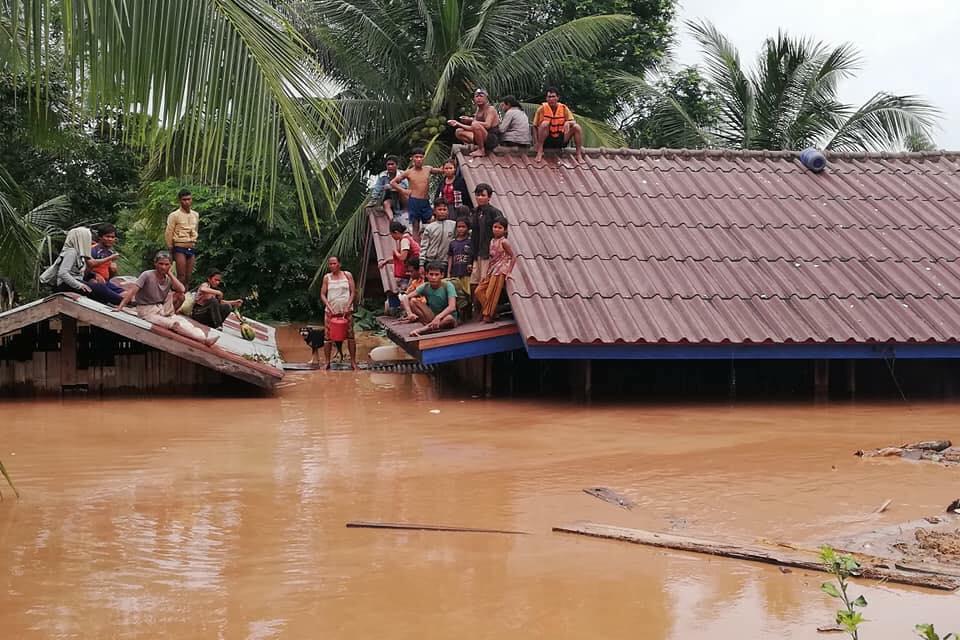
On July 23, 2018, the villagers of Attapeu, a sleepy town in southern Laos, suffered their worst nightmare when the Xe-Pian Xe-Namnoy hydropower dam suddenly burst, unleashing massive torrents of water that swallowed local villages, killing 71. More than 7,000 were made homeless.
The survivors lost all their property, homes, livestock and crops.
Two years on, despite all the promises made by state authorities and dam constructors regarding compensation, the villagers are still devastated. Although a few have been compensated, many still live in makeshift shelters made of canvas and galvanised sheets on relocation sites provided by the Lao government.
They are still waiting for new houses promised by the Xe-Pian Xe-Namnoy Power Company (PNPC), the developer of the 410-megawatt dam.
The project is a joint-venture formed by investors from South Korea, Thailand and Laos. About 86% of the electricity generated from this dam is sold to Thailand under a 27-year power purchase agreement. The rest is reserved for Lao state enterprises.
Indeed, one can hardly imagine the hardships the villagers have been going through living in makeshift accommodation. Over the past two years, they have depended on state assistance and public donations.
According to local media, numerous villagers have fallen sick from preventable ailments such as diarrhoea, eye infections and skin rashes. Those sicknesses raise questions about the sanitation of the relocation sites. Such living conditions affect villagers psychologically as they have lost the ability to live on their own.
Their grievances were captured by photographer Visarut Sankham who last week launched a photo exhibition in Bangkok to commemorate the 2018 disaster.
Mr Visarut, also a friend of mine, visited the temporary shelters last year, talking to the devastated villagers whose dreams of better lives have been shattered and whose future is now uncertain.
Among the affected villagers is Suhap Rajawong, a 32-year-old worker who had spent many years working in factories in Thailand. He saved a sum of money to open a wood factory in his home village. But all of his savings, together with his house, were swept away by the flood.
Another victim, Bunnung Srinun, 47, planned to start a sweet potato farm on a land plot he inherited from his father. He had planted rosewood trees on the plot 10 years previously and was about to harvest them when the mud-filled floods buried everything.
Other survivors told similar stories to Mr Visarut. Some had prepared money and properties for a clothing shop, a cockfighting ranch or a pig farm. But all were swept away. These are just a few of the sad stories.
SK Engineering & Construction Co, the dam's builder and PNPC's shareholder, promised to make up for the losses of the affected villagers. But the long delay in the compensation process has made the villagers feel uncertain. There are reports that the company has reached a US$92 million (2.8 billion baht) compensation deal with the Lao authorities. The deal was reportedly announced on July 9. It has come as no surprise that the process has been so sluggish.
I believe the compensation, albeit delayed, could help the villagers recover some of their livelihoods. Don't forget the villagers have to focus on how to feed their families while starting their plans from scratch.
While their livelihoods will likely not fully recover, the construction of the Xe-Pian Xe-Namnoy dam is complete. RATCH Group, a Thai firm holding a stake in the company, said the dam began operation on Dec 6 last year.
Although those troubled villagers may seem far apart from us in Bangkok, Mr Visarut said we should connect with them.
"We should think about those survivors [and their troubles] when we look at our electricity bills," he said.
"The visible damage to their properties can probably be estimated in numbers, but not the shattered dreams," Mr Visarut added. "The loss of their dreams and livelihoods does not add to our electricity bills. It's easier to ignore someone's losses when they're invisible to us."
Laos possesses untapped potential water resources as its one-party government plans to make the country "the battery of Southeast Asia". The Lao government has welcomed profit-seeking companies to invest and build several hydropower dams on the Mekong River and its tributaries, and export electricity generated from the dams to its neighbours.
This ambition happens to match Thailand's hunger for electricity, especially because the country's economy is driven by the energy-consuming tourism and service sectors.
But no one wants to pay high electricity costs. Thailand has searched for "cheap" energy alternatives, among them hydropower plants. But this power-generating method is deemed cheap only because social and environmental impacts are not added to its production costs.
We also know the Xe-Pian Xe-Namnoy disaster could have been prevented had the constructors applied advanced engineering technology and methodology data. Media reports suggested that the slow response to the problem was to blame for the failure to avert the disaster. As long as consumers are happy with cheap energy, there will always be people who have to offset the price of electricity. In this case, it's the villagers of Attapeu.
Their devastation should make us aware of the hidden problems in electricity generating, among them the unfair compensation process. We should do more as consumers to push for what is right for those who are underprivileged.
